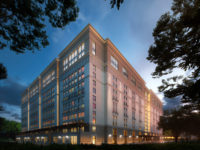A Masterpiece, With Shortcomings






Construction of the tower and its alternating square and circle floors in progress. Construction began on November 6, 1947.




The topping-out ceremony of the tower on October 15, 1949. Jake Stocker, the construction supervisor, is on the right.

On December 21, 2013, marking winter solstice, the longest night of the year, SC Johnson relit its Frank Lloyd Wright-designed Research Tower for the first time in 12 months. The lighting ceremony celebrated the extensive restoration to the tower, which involved both exterior and interior updates.

The Research Tower is 153 feet high, with 232 stairs that climb 15 stories.

The tower's unique taproot core design is illuminated by a sunset.



























Any list of the greatest buildings of the 20th century would have to include Frank Lloyd Wright’s SC Johnson Research Tower, the 15-story companion to his equally spectacular administration building in Racine, Wisconsin. On May 2, the company will begin offering tours of the tower for the first time since it was completed in 1950. Expect plenty of debate about whether a building with functional shortcomings can still be considered a masterpiece.
Built in 1950 and closed in 1982, the research tower, which Wright persuaded company president H.F. Johnson Jr. to build, was problematic from the start. True, during the first 10 years it was in use, the firm developed several of its best-known products, including Pledge, Glade, Raid, and Off!; for that reason, Greg Anderegg, the company’s director of global community affairs, says, “I think it worked pretty well.” But Wright’s 153-foot-high tower is inflexible—the small floor plates and built-in furniture ensured that new equipment wouldn’t fit. Worse, the building would be difficult to evacuate in an emergency. Its 13-foot-diameter core contains a small round elevator and a stairway that at some points is a mere 24 inches wide, but makes 180-degree turns. It’s hard to believe the building, without a single operable window, was used as long as it was. (Over the years, according to Anderegg, the company considered—and rejected—various means of creating an additional means of egress.)
And yet the building is spectacularly innovative, with its 15 floors, six of them circular mezzanines, cantilevered off a “taproot” core that extends 50 feet underground. (This may be the closest Wright ever came to creating a truly tree-like tower.) Its windows aren’t sheets of glass but stacks of Pyrex tubes, impractical to maintain but capable of producing gorgeous visual effects.
SC Johnson could have abandoned the building years ago; instead, the privately held company has lavished attention on it. It is in the midst of a five-year, $30 million renovation of the complex, which has so far included replacing every one of the 21,170 bricks and 5,800 Pyrex tubes that form the tower’s exterior. Inside, workers restored two of the floors to their original condition (even propping the spaces with 1950s scientific equipment, documents, and photos from company archives). Sean Malone, president of the Frank Lloyd Wright Foundation, calls the company’s acts “completely unselfish giving.” SC Johnson won’t even charge for tours, which will be offered on Fridays, Saturdays, and Sundays. Given the unreliability of the elevator and the narrowness of the stairs, the number of visitors admitted to the tower will be tightly controlled, and there will be no access for the disabled.
During a recent visit, the building’s charms were apparent. Indeed, the equipment used to “stage” the labs seems oddly out-of-place, a collection of antiques in a still-futuristic building. Also apparent were multiple shortcomings, including bathrooms that would barely pass muster on an airplane, and an inability to modulate natural light. (At one point, Johnson’s workers asked the company to issue them sunglasses.) And the spaces feel claustrophobic, with fresh air scarce and views distorted by the tubing.
But the building is connected by a Wright-designed bridge to the administration building, which is remarkably light and airy—it’s as if the two structures together demonstrate Wright’s penchant for “compression and release,” although, somewhat strangely, the compression happens in a tower. Some will see the tower’s interiors as proof that Wright cared more about form than function; others will recognize a triumph of architectural experimentation, conducted on behalf of a daring, and patient, client. Neither group of visitors will be disappointed.
For tours, visit scjohnson.com/visit or call (262) 260-2154.























